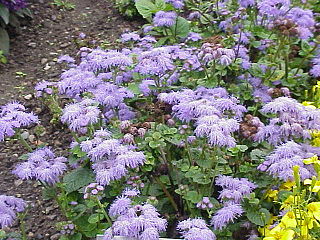
Eupatorieae is a tribe of over 2000 species of plants in the family Asteraceae. Most of the species are native to tropical, subtropical, and warm temperate areas of the Americas, but some are found elsewhere. Well-known members are Stevia rebaudiana, a number of medicinal plants (Eupatorium), and a variety of late summer to autumn blooming garden flowers, including Ageratum (flossflower), Conoclinium (mistflower), and Liatris.

Brickellia is a North American genus of about 100 to 110 species of plants in the family Asteraceae, known commonly as brickellbushes. They are found in Canada, the United States, Mexico, and Central America. Many species are native to the American southwest, especially Texas. Brickellia is among the more basal lineages of the Eupatorieae and should not be assigned to a subtribe pending further research.
Flyriella is a genus of perennial flowering plants in the family Asteraceae, and the species are commonly called brickellbush. They are native to Texas and Mexico.
Carminatia is a genus of annual plants in the family Asteraceae. They are native primarily to Mexico, but also the southwestern United States and Central America.
Trichocoronis is a genus of North American aquatic plants in the tribe Eupatorieae within the family Asteraceae. Bugheal is a common name for plants in this genus.
Alomia is a genus of flowering plants in the family Asteraceae, described as a genus in 1818.
Asanthus is a small genus of flowering plants in the family Asteraceae, found only in northern Mexico and the southwestern United States.
Barroetea is a genus of flowering plants in the family Asteraceae.
Brickelliastrum is a North American genus of flowering plants in the tribe Eupatorieae within the family Asteraceae. Brickelliastrum has at times been lumped with Brickellia or Steviopsis, but chromosome number (x=10) and molecular data are in agreement in showing that it is distinct from either of these. Despite having the general appearance of Brickellia, members of Brickelliastrum have cypselae that have only 5-7 ribs (vs. 10), funnel-shaped corollas, and a style with an unenlarged, glabrous base.
Decachaeta is a genus of Mesoamerican flowering plants in the family Asteraceae.
Dyscritogyne is a genus of Mexican flowering plants in the family Asteraceae.
Erythradenia is a genus of flowering plants in the family Asteraceae.

Hofmeisteria is a genus of Mexican flowering plants in the family Asteraceae.

Jaliscoa is a genus of Mexican flowering plants in the family Asteraceae.
Kyrsteniopsis is a genus of Mexican flowering plants in the family Asteraceae.

Microspermum is a genus of Mexican flowering plants in the tribe Eupatorieae within the family Asteraceae.
Oxylobus is a genus of Mesoamerican flowering plants in the tribe Eupatorieae within the family Asteraceae.
Phanerostylis is a genus of Mexican plants in the tribe Eupatorieae within the family Asteraceae.

Piqueria is a genus of Caribbean and Mesoamerican plants in the tribe Eupatorieae within the family Asteraceae.
Asanthus thyrsiflorus is a Mexican species of plants in the family Asteraceae. It is native to the states of San Luis Potosí, Chihuahua, Zacatecas, Aguascalientes, Jalisco, Coahuila, and Durango in north-central Mexico.





